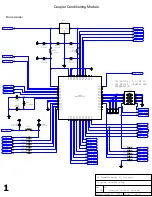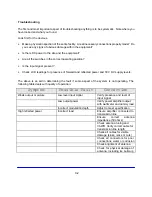
Technalogix Ltd
.
VIII-4
Antenna and Tower Recommendations
Your preliminary engineering workgroup should establish your antenna and tower requirements, both
for receiving and transmitting antennas. Construction of sturdy, high quality antenna/tower systems will
pay off in terms of coverage of your service area, the overall quality and saleability of your radiated
signal, and reduced maintenance expenses. Technalogix provides complete turnkey antenna systems
if needed. If your site is serving as a translator, your receiving antenna should be in line of sight to the
originating station all year round. The foliage will change with season. Transmitting antennas can
enhance or seriously impair the transmitter/translator output.
The selection, routing, and length of coaxial cable are extremely important in the installation. If there is
a 3 dB line loss in the cable between your unit’s output and the transmitting antenna, a 100-watt unit
will only deliver 12.5 watts to the antenna. Buy the best cable you can obtain, route it via the shortest
way to the antenna, and keep it straight. Do not form it into sharp bends on its way. Do not use any
more cable fittings for the installation than absolutely necessary. All cautions here apply equally to all
coaxial cables in the system - input and output.
Pay attention to radial ice accumulation when designing the transmission system. It is not uncommon
for at least an inch of ice to build up on the tower and antenna. This in turn significantly increases the
weight, cross section, and wind loading of the system.
Attaching the transmission line to the tower is crucial to maintain a safe and reliable operation. Nylon
wire ties and electrical tape will breakdown in the sunlight and ultimately fail, creating a potentially
dangerous situation. It is important to use proper clamps and hoisting grips and also ensure that the
transmission line is grounded to the tower in several locations. When high currents flow through the
tower in the event of lightening strikes, some of that current will through the outer conductors of the
transmission lines. Due to the resistance difference between the steel tower and copper transmission
line, a significant voltage can be developed, often resulting in arcing between the outer jacket and
outer conductor, thus pitting the conductor.
Preventative maintenance is crucial in ensuring that safety is maintained. Specifically, check that
transmission line grounds are tight and are not missing any hardware. Frequently inspect support
clamps or spring hangers. Consider investing in an ice break, if you haven’t already done so, as
shards of falling ice can damage the transmission line – and if it is going to happen, it will happen at an
important time. Check the tower light photocells and conduit.
The better-known tower manufacturers offer complete technical and safety documentation with their
towers. Be sure that you have this information as it regards wind loading, guying, etc. The best-
designed antenna system will function poorly if shortcuts and compromises are used during installation.
Follow the manufacturer’s instructions exactly, along with any engineering data prepared for the site.
Be absolutely safe and certain about this aspect as human lives may be at stake.










































